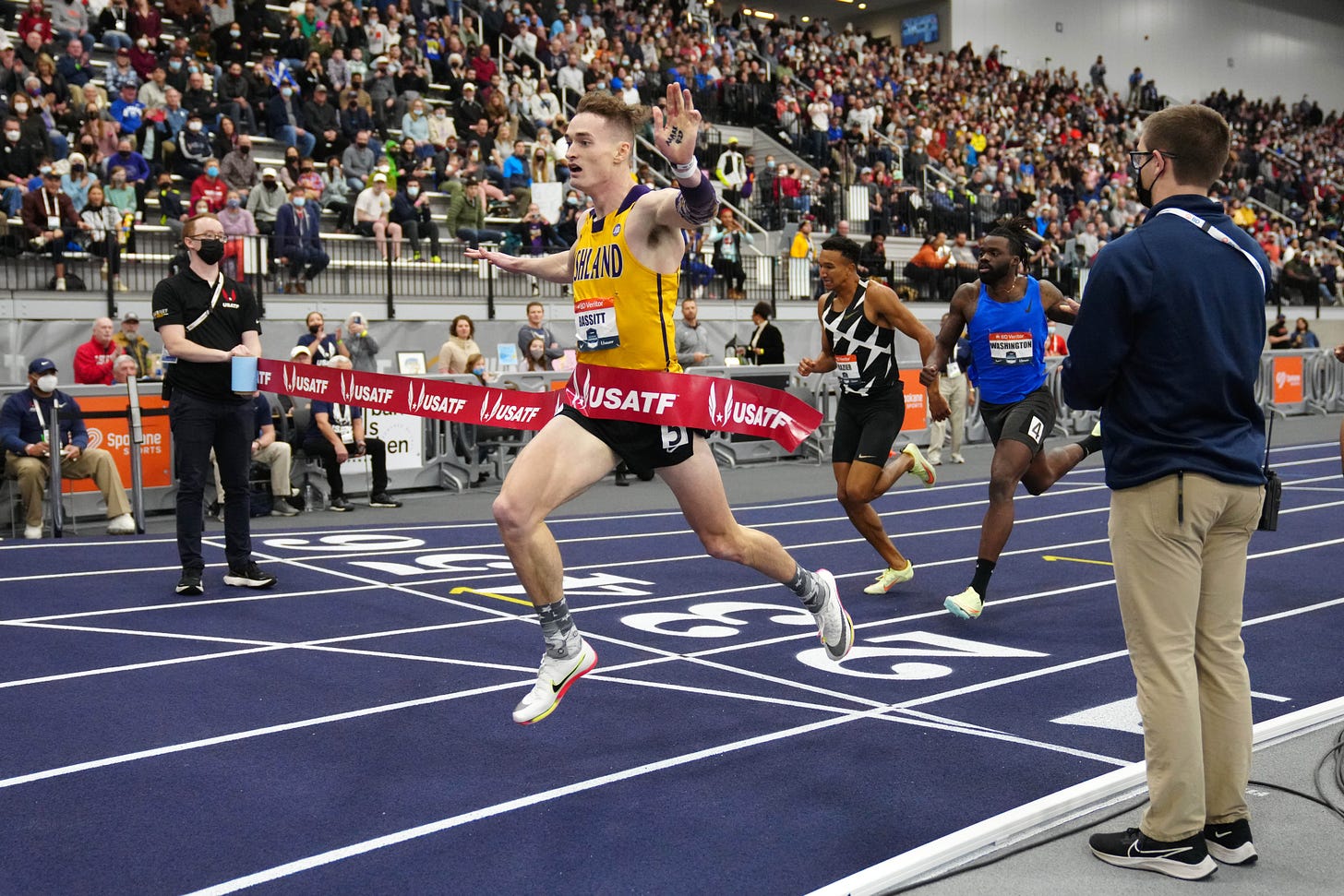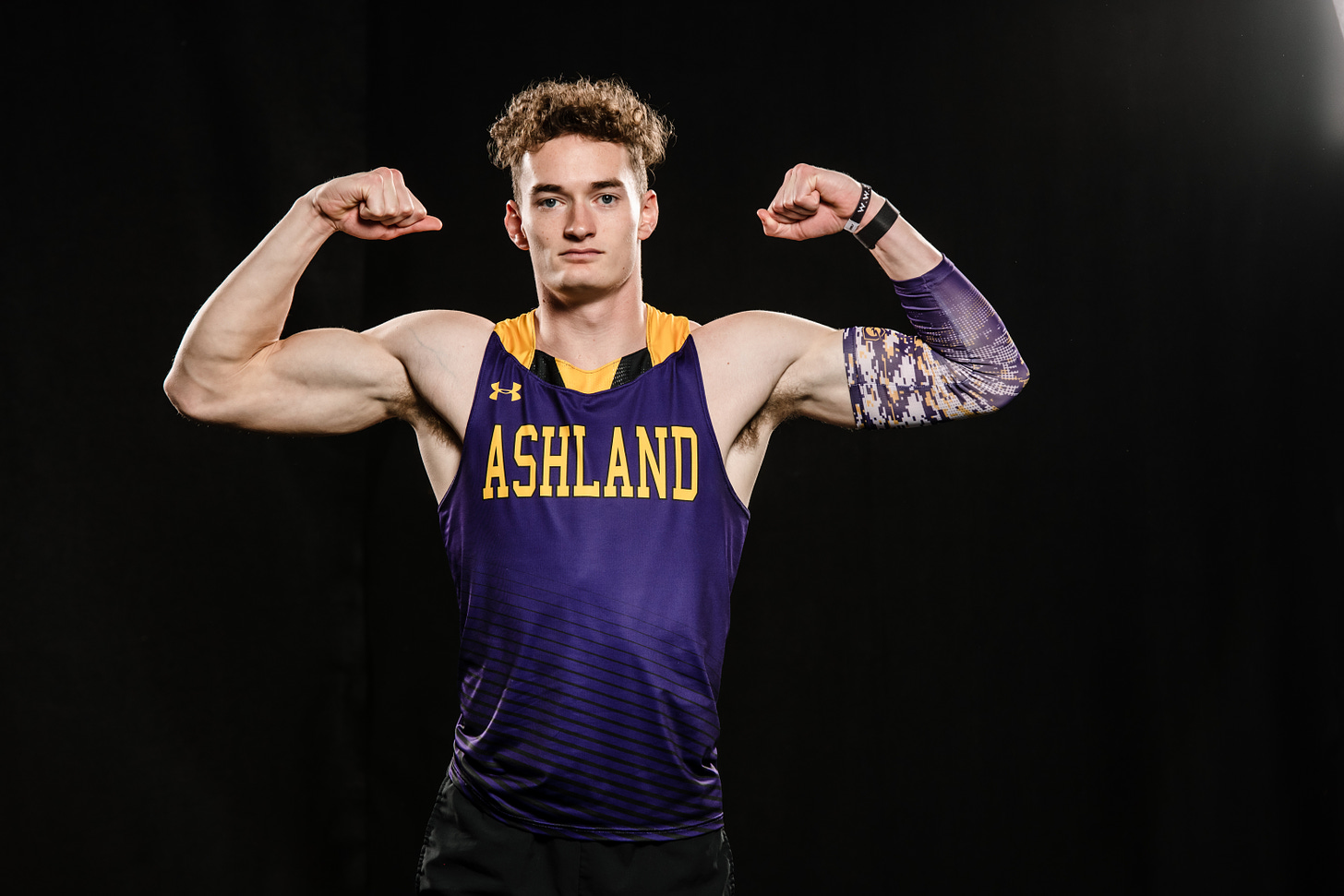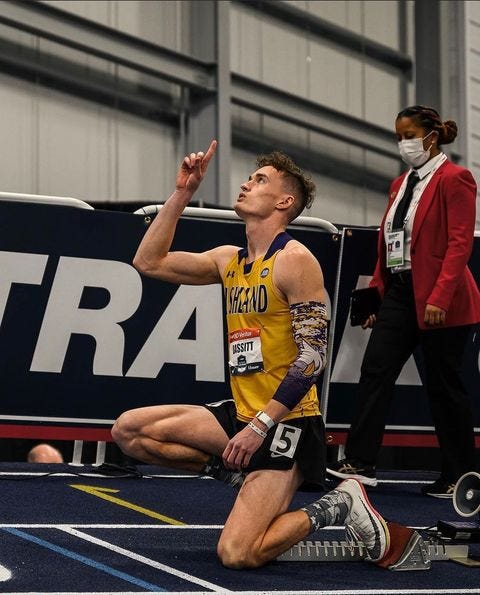
Don’t get Trevor Bassitt wrong.
The fifth-year senior from Ashland University deeply appreciates all the praise and congratulatory messages he has received since winning the men’s 400 meters in the USA Track & Field Indoor Championships at The Podium in Spokane, Washington, on February 27.
He knows many track and field fans think it’s a wonderful Cinderella story that an athlete from an NCAA Division II school such as Ashland will be part of the United States team competing in the World Athletics Indoor Championships in Belgrade, Serbia, this weekend.
However, he was not surprised by his victory, and he will not be satisfied with just taking part in the meet when he settles into the starting blocks for a first-round heat of the men’s 400 at 6 a.m. Eastern Daylight Time on Friday.
As he posted on Instagram: We didn’t come this far just to come this far.
“I feel like I have a very real shot, and a very good shot, to win the 400,” he said during a Zoom interview on March 7. “And I know we have a four-by-four team that can win. The goal is to go there, and run a fast enough time in both events to win both of them. I’m not concerned with running personal bests in these kinds of meets anymore because at championship meets, you can run fast. But at the end of the day, it’s about who crosses the line first, second, or third. The goal is to leave there with two gold medals.”
Bassitt, 24, runs the 400 indoors to prepare for the 400 intermediate hurdles – his primary event – outdoors. He is listed as the second fastest entrant in the World Indoor meet, based on his winning time of 45.75 from the USATF Championships. However, he set a meet record of 45.36 to win the NCAA Division II Indoor Championships last Saturday, a performance that tops the leading entry time of 45.48 for Liemarvin Bonevacia of the Netherlands.
“I would not be surprised if he wins the Worlds,” said Cory Holman, who is in his first year as the sprints and hurdles coach at Ashland. “Trevor is a competitor... like, a competitor. I am more than confident he will be able to do what he needs to do in both the 400 and the four-by-four. I can see him getting nervous, but I don’t see it hindering his performance.”
Holman was hired by Ashland to replace Ernie Clark, who left the school to become the sprints and hurdles coach at San Jose State.
Clark was the one who recruited Bassitt to Ashland from Bluffton High School in Ohio, telling him he could be a Division II champion in the intermediate hurdles during his time at the school. But he and Holman have much higher aspirations for Bassitt this year.
They feel he has a legitimate chance to place among the top three finishers in the intermediate hurdles in the USA Track & Field Championships in June and qualify for the U.S. team that will compete in the World Athletics Championships at Hayward Field in Eugene, Oregon, from July 15-24.
It would be easy to attribute their contention to a pair of coaches being overly optimistic when speaking of an athlete whom they call a great team leader who always gives 110 percent in practice.
But it does not seem implausible when you consider Bassitt ran a personal best of 48.80 in the intermediates to win an American Track League race in Nashville last June. He defeated a field that included runner-up Kenny Selmon, who 20 days later ran a personal best of 48.08 to place second in the U.S. Olympic Trials.
Bassitt advanced to the final of the Trials, but finished eighth in 50.03 after missing a ton of training during the previous six weeks due to severe pain in both of his ankles.
The pain, which is believed to have been caused by aggravated nerves, forced him to bypass the 110 high hurdles and the 400 intermediates in the NCAA Division II championships in late May of last year and resulted in him training little before his victory in Nashville.
“There is no doubt he was going to go 47-point in the Trials,” Clark said. “In my mind, he was going to go 47.4 to 47.5.”
Bassitt did not mention the injury issues when talking about the Trials, but Clark said he told him back then he would never again not make a U.S. team.
“It was painful and it hurt not to accomplish what he had set out to do,” Clark said. “His being in the Olympic Trials final was not an accident, but his plans were bigger than that and it didn’t work out and that hurt.”
Now 6-feet 4-inches and 180 pounds, Bassitt was a 6-3, 140-pound high school senior who won the 300 intermediate hurdles and placed second in the 110 high hurdles in the Division III finals of the 2017 Ohio State Championships after winning the high hurdles as a junior.
With bests of 14.26 in the high hurdles and 37.94 in the intermediates, he was a good but not great high school hurdler who was not ranked among the top 50 performers nationally in either event in 2017. But he was happy to continue his track career at Ashland.
“My goal was always to be a college athlete,” he said. “I never gave any thought to making a U.S. national team until my sophomore year in college when I advanced to the semifinals of the USA nationals in the intermediates. I realized then that a couple more years of hard work and growing a little bit could make that happen.”
Clark figured Bassitt had a huge upside because he had participated in some of Clark’s speed and hurdling camps when he was in high school. He was impressed with his dedication, willingness to work, and eagerness to learn the technical aspects of hurdling. He also thought Bassitt’s performances would improve significantly when he matured physically.
“I remember telling my wife that this guy is not totally coordinated yet and he’s not strong enough for his limbs,” Clark said. “But this guy is going to be incredible at age 22, because I was a guy who was a very uncoordinated athlete from eighth grade until my sophomore, if not my junior year, of high school. But then as I got stronger and more coordinated, I became a much better athlete.”
Bassitt admits he was a late bloomer, but he has also gotten bigger and stronger because he has worked out diligently in the weight room, particularly during the fall and off-season. He said squats and the clean and jerk are the two lifts that have proved particularly beneficial to him.
The strength gained through weight lifting has helped make Bassitt a strong finisher in both the 400 and the intermediate hurdles.

As Holman points out, even when Bassitt is exhausted in the final 100 meters of a race, “It doesn’t look like he’s dying because his stride is still long and he’s still pumping his arms.”
Bassitt says it is critically important to get out well in the first 200 of the 400 indoors because races are run on 200-meter tracks and competitors are allowed to break to the inside lane after completing the first two curves running in lanes.
“It’s really hard to pass people on a 200 banked track because you pretty much can’t pass on the curve,” he said. “So you either need to have a lead after the break or be right on someone’s shoulders and be able to make a move once you hit the backstretch. My number-one goal is always to win the break if I can.”
Bassitt was in second place after the first lap of the USATF meet, but powered past leader Noah Williams as they entered the backstretch of the second lap and finished nearly four tenths of a second ahead of runner-up Donovan Brazier, the 2019 world champion in the 800.
“I had to make a split-second decision,” Bassitt said. “And I said to myself, ‘I have to go right now. I might die at the end if I go by him right here, but if I don’t, I don’t have a chance to win.’ If you try to make that move late, it’s very risky. You’re almost banking on your opponents finishing poorly.”
Tom Bassitt, Trevor’s dad, expects his son to run well in Belgrade because he “has always done better than expected on the big stage. He did it in high school when he came from a D III school in Ohio and he has done it at Ashland, which is a D II school.”
Trevor has been preaching since his arrival at Ashland that division does not make a difference. All that matters is the time on a clock. But he is proud to be from a Division II program.
“Being able to go to the USATF Champs as a Division II guy fresh off making the finals of the Olympic Trials meant something,” he said. “I will take a lot of pride in representing Division II as a whole overseas.”




